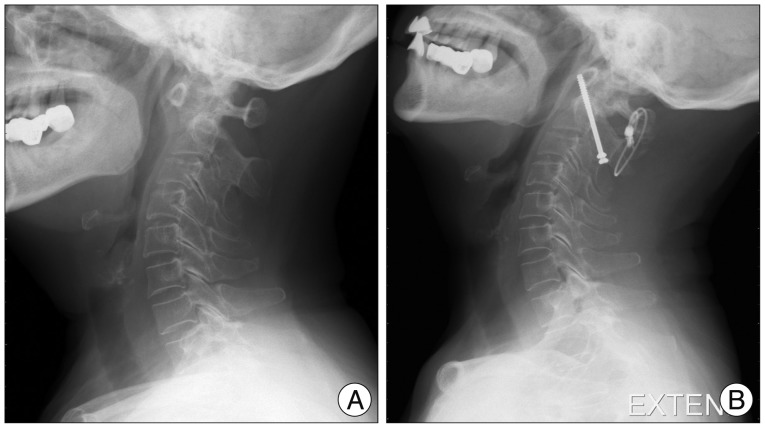J Korean Neurosurg Soc.
2014 May;55(5):255-260. 10.3340/jkns.2014.55.5.255.
Comparison of Outcomes after Atlantoaxial Fusion with Transarticular Screws and Screw-Rod Constructs
- Affiliations
-
- 1Department of Neurosurgery, Korean Armed Forces Busan Hospital, Busan, Korea.
- 2Department of Neurosurgery, Spine and Joint Research Institute, Guro Teun Teun Hospital, Seoul, Korea.
- 3Department of Neurosurgery, Inha University College of Medicine, Incheon, Korea. nsyoon@gmail.com
- KMID: 2018030
- DOI: http://doi.org/10.3340/jkns.2014.55.5.255
Abstract
OBJECTIVE
The purpose of this study was to compare the radiological and neurological outcomes between two atlantoaxial fusion method for atlantoaxial stabilization; C1 lateral mass-C2 pedicle screws (screw-rod constructs, SRC) versus C1-2 transarticular screws (TAS).
METHODS
Forty-one patients in whom atlantoaxial instability was treated with atlantoaxial fixation by SRC group (27 patients, from March 2005 to May 2011) or TAS group (14 patients, from May 2000 to December 2005) were retrospectively reviewed. Numeric rating scale (NRS) for pain assessment, Oswestry disability index (ODI), and Frankel grade were also checked for neurological outcome. In radiologic outcome assessment, proper screw position and fusion rate were checked. Perioperative parameters such as blood loss during operation, operation time, and radiation exposure time were also reviewed.
RESULTS
The improvement of NRS and ODI were not different between both groups significantly. Good to excellent response in Frankel grade is shown similarly in both groups. Proper screw position and fusion rate were also observed similarly between two groups. Total bleeding amount during operation is lesser in SRC group than TAS group, but not significantly (p=0.06). Operation time and X-ray exposure time were shorter in SRC group than in TAS group (all p<0.001).
CONCLUSION
Both TAS and SRC could be selected as safe and effective treatment options for C1-2 instability. But the perioperative result, which is technical demanding and X-ray exposure might be expected better in SRC group compared to TAS group.
Keyword
Figure
Cited by 1 articles
-
Unilateral C1 Lateral Mass and C2 Pedicle Screw Fixation for Atlantoaxial Instability in Rheumatoid Arthritis Patients: Comparison with the Bilateral Method
Seung-Chull Paik, Hyoung-Joon Chun, Koang Hum Bak, Jeil Ryu, Kyu-Sun Choi
J Korean Neurosurg Soc. 2015;57(6):460-464. doi: 10.3340/jkns.2015.57.6.460.
Reference
-
1. Brooks AL, Jenkins EB. Atlanto-axial arthrodesis by the wedge compression method. J Bone Joint Surg Am. 1978; 60:279–284. PMID: 348703.
Article2. Coyne TJ, Fehlings MG, Wallace MC, Bernstein M, Tator CH. C1-C2 posterior cervical fusion : long-term evaluation of results and efficacy. Neurosurgery. 1995; 37:688–692. discussion 692-693. PMID: 8559297.3. Dickman CA, Crawford NR, Paramore CG. Biomechanical characteristics of C1-2 cable fixations. J Neurosurg. 1996; 85:316–322. PMID: 8755762.
Article4. Dickman CA, Sonntag VK. Posterior C1-C2 transarticular screw fixation for atlantoaxial arthrodesis. Neurosurgery. 1998; 43:275–280. discussion 280-281. PMID: 9696080.
Article5. Elliott RE, Tanweer O, Boah A, Morsi A, Ma T, Frempong-Boadu A, et al. Outcome comparison of atlantoaxial fusion with transarticular screws and screw-rod constructs : meta-analysis and review of literature. J Spinal Disord Tech. 2014; 27:11–28. PMID: 23128387.
Article6. Farey ID, Nadkarni S, Smith N. Modified Gallie technique versus transarticular screw fixation in C1-C2 fusion. Clin Orthop Relat Res. 1999; (359):126–135. PMID: 10078135.
Article7. Gallie WE. Fractures and dislocations of the cervical spine. Am J Surg. 1939; 46:495–499.
Article8. Goel A, Desai KI, Muzumdar DP. Atlantoaxial fixation using plate and screw method : a report of 160 treated patients. Neurosurgery. 2002; 51:1351–1356. discussion 1356-1357. PMID: 12445339.
Article9. Goel A, Laheri V. Plate and screw fixation for atlanto-axial subluxation. Acta Neurochir (Wien). 1994; 129:47–53. PMID: 7998495.
Article10. Haid RW Jr, Subach BR, McLaughlin MR, Rodts GE Jr, Wahlig JB Jr. C1-C2 transarticular screw fixation for atlantoaxial instability : a 6-year experience. Neurosurgery. 2001; 49:65–68. discussion 69-70. PMID: 11440461.
Article11. Harms J, Melcher P. Posterior C1-C2 fusion with polyaxial screw and rod fixation. Spine. 2001; 26:2467–2471. PMID: 11707712.
Article12. Jeon SW, Jeong JH, Choi GH, Moon SM, Hwang HS, Choi SK. Clinical outcome of posterior fixation of the C1 lateral mass and C2 pedicle by polyaxial screw and rod. Clin Neurol Neurosurg. 2012; 114:539–544. PMID: 22130046.
Article13. Lee SH, Kim ES, Sung JK, Park YM, Eoh W. Clinical and radiological comparison of treatment of atlantoaxial instability by posterior C1-C2 transarticular screw fixation or C1 lateral mass-C2 pedicle screw fixation. J Clin Neurosci. 2010; 17:886–892. PMID: 20399666.
Article14. Low HL, Redfern RM. C1-C2 transarticular screw fixation for atlantoaxial instability : a 6-year experience, and C1-C2 transarticular screw fixation-technical aspects. Neurosurgery. 2002; 50:1165–1166. author reply 1166. PMID: 11987276.
Article15. Madawi AA, Casey AT, Solanki GA, Tuite G, Veres R, Crockard HA. Radiological and anatomical evaluation of the atlantoaxial transarticular screw fixation technique. J Neurosurg. 1997; 86:961–968. PMID: 9171174.
Article16. Magerl F, Seemann PS. Stable posterior fusion of the atlas and axis by transarticular screw fixation. In : Kehr P, Weidner A, editors. Cervical Spine I. Vienna: Springer-Verlag;1987. p. 322–327.17. Papagelopoulos PJ, Currier BL, Hokari Y, Neale PG, Zhao C, Berglund LJ, et al. Biomechanical comparison of C1-C2 posterior arthrodesis techniques. Spine (Phila Pa 1976). 2007; 32:E363–E370. PMID: 17545899.
Article18. Paramore CG, Dickman CA, Sonntag VK. The anatomical suitability of the C1-2 complex for transarticular screw fixation. J Neurosurg. 1996; 85:221–224. PMID: 8755749.
Article19. Reilly TM, Sasso RC, Hall PV. Atlantoaxial stabilization : clinical comparison of posterior cervical wiring technique with transarticular screw fixation. J Spinal Disord Tech. 2003; 16:248–253. PMID: 12792338.
Article20. Solanki GA, Crockard HA. Peroperative determination of safe superior transarticular screw trajectory through the lateral mass. Spine (Phila Pa 1976). 1999; 24:1477–1482. PMID: 10423794.
Article
- Full Text Links
- Actions
-
Cited
- CITED
-
- Close
- Share
- Similar articles
-
- Old Atlantoaxial Rotary Subluxation Associated with High-riding Vertebral Arteries: Arthrodesis Using C1 Lateral Mass Screws and C2 Laminar Screws: A Case Report
- Biomechanical Study on Three Screw-Based Atlantoaxial Fixation Techniques: A Finite Element Study
- Clinical and Biomechanical Analysis of Transarticular Screw Fixation for Atlantoaxial Instability
- Atlantoaxial Fixation using Rod and Screw for Bilateral High-riding Vertebral Artery
- Posterior C1-2 Transarticular Screw Fixation in Atlantoaxial Instability




